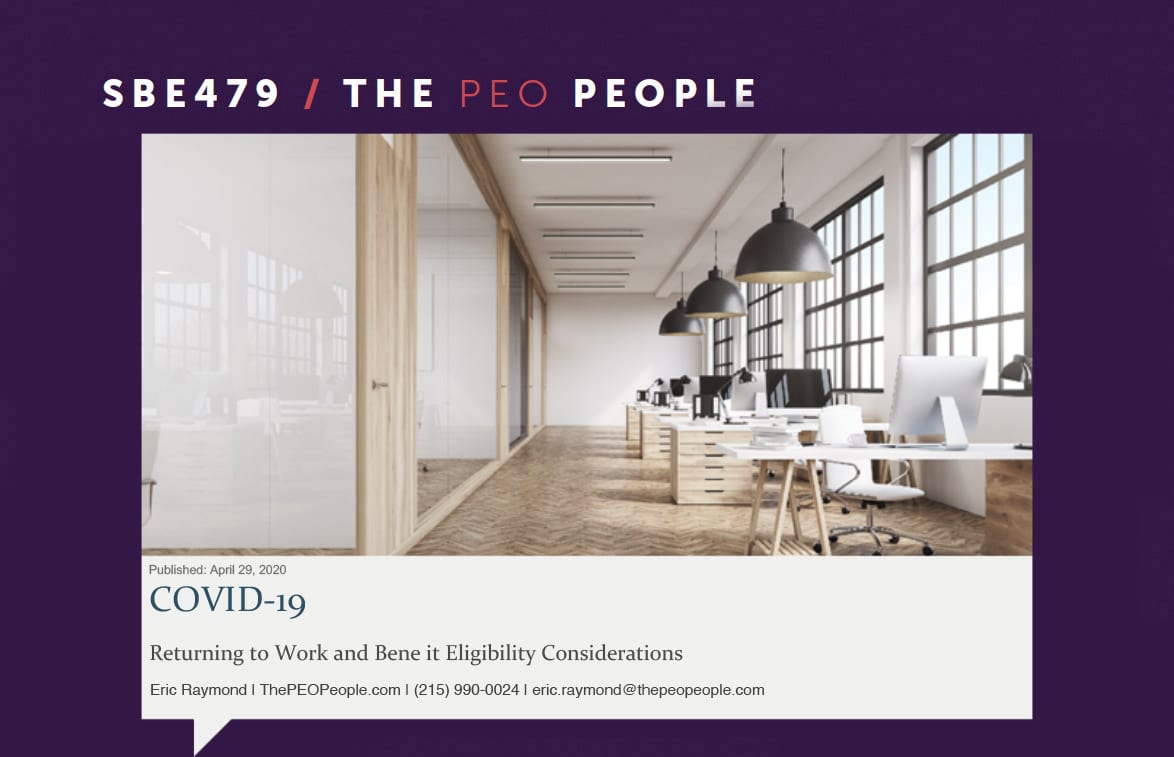
COVID-19 COVID Insurance Eligibility.
Employers with employees returning to work after a leave of absence, reduction in hours (e.g., furlough) or termination of employment (e.g., layoff) may have questions about the implications for medical benefit eligibility and the effect on the ACA’s employer shared responsibility rules.
Eligibility
The answer to the benefit eligibility question will depend heavily on whether the employee was terminated from employment (a termination and rehire) or kept active as an employee (e.g., while on furlough) with continued benefit eligibility. Employers should first determine whether the plan document addresses furloughs, rehires, or unpaid leaves of absence. If the employer is interested in waiving waiting periods for rehired employees or otherwise extending coverage beyond what is described in the plan document, it should make sure to get the carrier’s approval and amend the plan document if necessary.
Click here to talk to a PEO-OLOGIST directly about your benefit eligibility and COVID-19 questions and how a PEO can help.
Premium Payments
If employment was not terminated due to COVID-19 and the employee was kept active on health benefits, the employer may resume taking employees’ premiums out of the employees’ pay. The employer may recoup the cost of any missed contributions during the period the employee was furloughed without pay. Employers should check state wage and hour laws, as some states have limits on what can be deducted from an employee’s pay.
Cafeteria Plan
Considerations
Restoring Previous Elections
An individual rehired within 30 days may only make a new
election if there has been an intervening event that would permit an election
change. When more than 30 days have elapsed between an employee’s termination
and rehire, the cafeteria plan may (by design) allow a new election or require
the old election to be reinstated.
Status Change with No Loss of Eligibility
These are hard things for a business owner to keep track of. COVID-19 has created some uncertain times. Set up a time to talk to a PEO-OLOGIST and discuss how a PEO can help with all these annoying tasks that way you can focus on keeping and driving more business.
If an employee has a reduction in hours but maintains eligibility under the plan, he or she should generally not be given the opportunity to drop or change a pre-tax salary reduction election to discontinue benefits. There must be both a status change such as a commencement of an unpaid leave of absence and the status change must affect eligibility under an employer plan (except for group term life insurance, dismemberment, or disability coverage). However, there are two exceptions:
- Benefits can be discontinued for nonpayment of premiums when an employee is on an unpaid leave.
- A cafeteria plan may allow an employee to prospectively revoke an election of coverage under a group health plan that provides minimum essential coverage or better coverage when there is a reduction in hours of service of a full-time employee that otherwise does not affect group health plan eligibility. Cafeteria plans are often not amended to address this circumstance.
ACA Considerations
Full-Time Status under the ACA
Some employers may be rehiring employees after COVD-19 who were previously considered full-time employees under ACA rules. If the employee is rehired within 13 weeks (26 weeks for education organizations), the employee will be considered a continuing employee. This means that if the full-time employee was enrolled in coverage, s/he should be offered coverage no later than the first day of the month following the resumption of services. If the employee is rehired after more than 13 weeks (26 weeks for educational organizations), the employee may be treated as a new employee and subject to a new waiting period (or a new initial measurement period if the employee is a part-time, variable hour, or seasonal employee). Part-time, variable hour, and seasonal employees rehired after the end of a stability period do not need to be offered coverage unless the employee worked enough hours during the previous measurement period (pre-COVID-19) to achieve full- time status for the subsequent stability period. COVID-19 is creating a lot of HR questions and we know you are trying to focus on marketing. Call a PEO-OLOGIST to find out how a PEO can help you save money and be your HR and legal backup.
Hours of Service
Hours of service do not include hours incurred after the employee has terminated, or when payment is made or due under a plan maintained solely for the purpose of complying with applicable workers’ compensation, unemployment compensation, or disability insurance laws. When counting an employees’ hours to determine full-time employee status under the ACA look-back rules, hours of service include periods where the employee is entitled to pay due to vacation, holiday, illness, incapacity (including disability unless coverage was paid for after-tax and no employer contributions), and leaves of absence (including leave taken under the Families First Coronavirus Response Act).
Set up a quick 15 min call with a PEO-OLOGIST.


